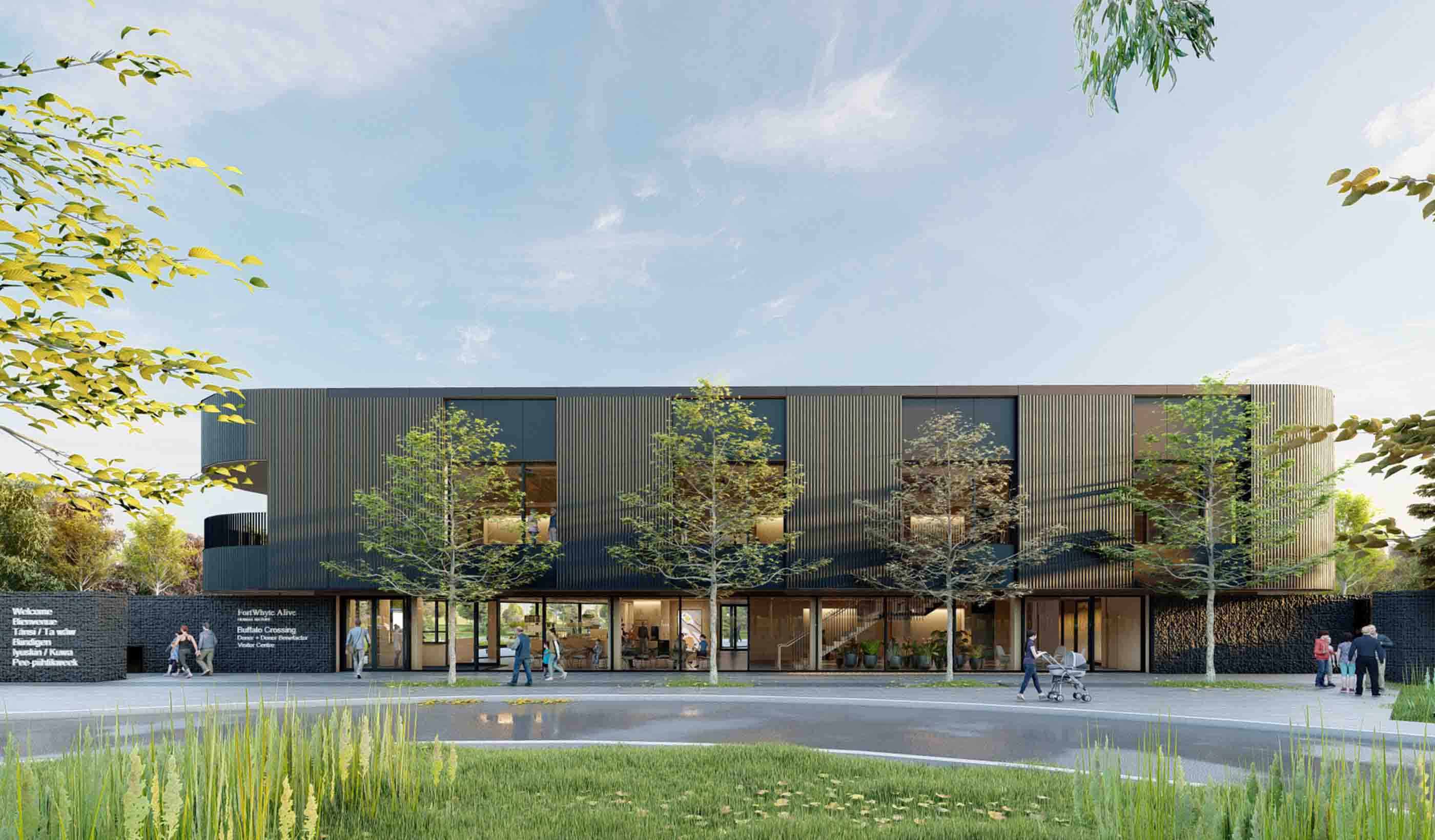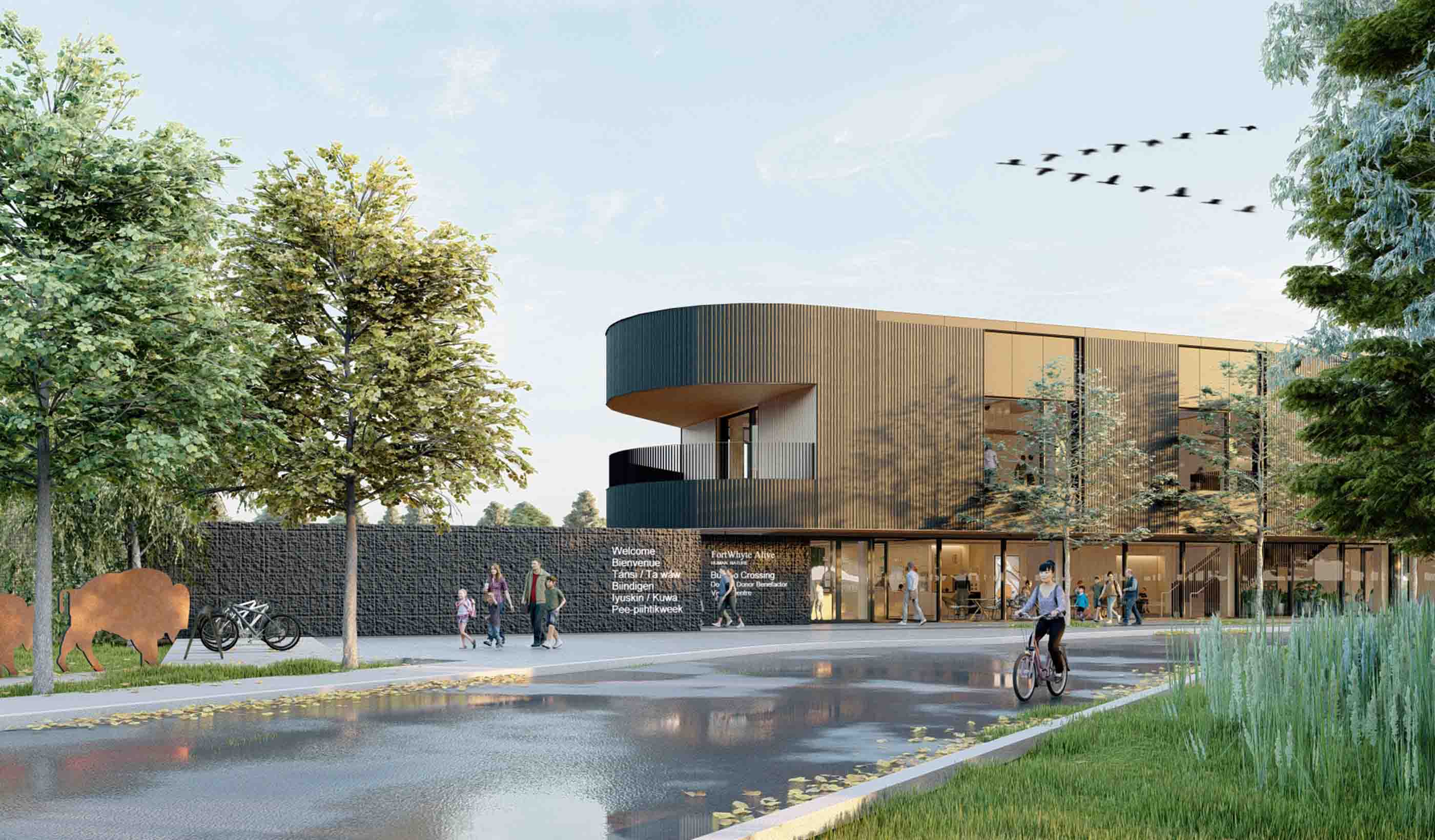Designing for a client’s nature-driven mission
September 28, 2022
September 28, 2022
Creating a living example of respect for nature through mass timber and passive house solutions
This blog first appeared as “Mission Driven” in Stantec Design Quarterly, Issue 16.
A client’s mission as reflected in its culture is always at the forefront of our designs. When that mission intersects with our passion for innovation that contributes to low-carbon, sustainable buildings in our communities, it sparks inspiration.
The design is complete for Buffalo Crossing, a new visitor center for our client FortWhyte Alive. Now is a great time to look back on the design approaches that helped us find inspiration, realize our client’s mission, and yield extraordinary results.
Here are eight approaches we used in the design for Buffalo Crossing to advance FortWhyte Alive’s mission.

The Buffalo Crossing Visitor Centre in Winnipeg, Manitoba, where passive house design was critical.
FortWhyte Alive is a nonprofit environmental education and recreation organization in Manitoba. It teaches children and the public about the natural world, the impacts of climate change, and it encourages sustainability. Its campus, located in southwest Winnipeg, includes an interpretive center, reception center, and FortWhyte Farms—a social enterprise that instructs Indigenous and urban youth about market farming, business, and woodworking. The final piece in its campus plan is the addition of a new visitor center and event space to act as a gateway to its vast trail network.
FortWhyte Alive doesn’t build often. So, this project needed to create something lasting and effectual within a budget. Not only did our design need to forward FortWhyte Alive’s educational mission, but it should exemplify a low-carbon approach, ideally one that could be used to educate and inspire action.
FortWhyte Alive requested an 18,000-square-foot, passive house-certified visitor center with parking. It needed educational space—indoor and out—a bridge over one of the lakes on site (the reclaimed industrial site sits on the Canada Cement Company’s former clay and gravel mines), an observation tower, and an accessible dock for canoes and kayaks.
Project goals were ambitious. The visitor center project will expand programming capacity. Beyond that, the client wanted the building to generate revenue as an educational and event space, connect community members to each other and with nature, and act as a highly visible living exhibit of FortWhyte Alive’s values—to motivate the community to action. FortWhyte Alive wanted to influence design and building culture itself by demonstrating the possibilities for low-carbon design, providing an example that other organizations can follow with their future buildings.
The client asked us for a building that would last a century. Therefore, resilience—in the face of a changing climate—was a major factor for our design.
The client asked us for a building that would last a century. Therefore, resilience—in the face of a changing climate—was a major factor for our design. Today, Manitoba’s extreme climate zone averages temperatures of -33°C (-27°F) in winter and 29°C (84°F) in summer. But experts predict that in 60 to 80 years the average will change, resulting in warmer and wetter winters along with longer, warmer, and drier summers.
To achieve an enduring and resilient building design, we had to anticipate these varying climate extremes.
The client’s goal for a low-carbon, passive house building led the way to an architectural and engineering solution. The entire project team (client, designers, and construction manager) took a course in passive house design to make sure everyone was ready to apply design thinking to reduce the building’s energy load. Passive house basics include a highly insulated building envelope with insulating glass, ventilation heat recovery, extreme air tightness, absence of thermal bridging (such as building corners), compact building shape (low surface area to volume ratios), and a building orientation that optimizes solar-energy harvesting.
First, we looked to these passive house principles to minimize energy consumption and loss. Then we looked to innovative building systems and operational solutions to further reduce the building’s energy demand. Designing a building where groups of people congregate that also meets stringent passive house standards required the design team to consider the impact of changing occupancy loads on heating and cooling. Working closely as a team we considered the site, climate, building form, systems, and program. We quickly realized there were limited options for achieving the high-level energy performance target.
Passive house principles drove much of the design. For example, our design solution avoids windows on the north face (relying on the solar heat gain from south-facing windows). It also reduces the number of building corners, which passive house considers thermal bridges where energy is lost.
The building also required a strong visible presence from the motorway but needed to be compact and simple to support its multiuse nature while maintaining a low appetite for carbon. Our solution was to reduce the north-facing façade through a triangular geometry with three rounded corners. This creates two balconies, which offer a view across the site’s acres of bucolic naturalized aspen parkland forest.
Passive house principles required the team to look at weather data and solar orientation to position the building for the best energy performance. Rotating the triangular building about 27 degrees opened spectacular views, while capturing the sun’s late afternoon rays for daylighting and warmth. We validated the triangular geometry through routine energy modeling studies and compared it to other schemes such as a simple stacked box to optimize form, orientation, and glazing for solar gain and views. We discovered that the design offering the best views with a strong physical presence from the motorway also optimized the building for heating and cooling.

Including curves in the Buffalo Crossing Visitor Centre reduces the number of building corners, which passive house considers thermal bridges where energy is lost.
In passive house design, the smaller, simpler, and more compact the heating, cooling, and ventilation system, the better. Our minimalist approach to the system design presents a nearly invisible solution with no unsheltered ducts across the exposed ceilings. A compact centralized service stack connects the lobby to the multipurpose room on the ground floor and the pre-function area to event space on the second floor, where all the ventilation supply and return air is distributed.
On the ground floor, a heat pump connects an underground geothermal field to concrete slabs on each floor with in-floor heating and cooling. The heat recovery ventilator is tucked away on a mezzanine above the event space and enables the building to preheat incoming air, add or remove humidity in the winter months, and the reverse on the cooling side during the summer months. These strategies support achievement of a targeted 90% improvement in energy efficiency than Canada’s National Energy Code requires.
Passive house was created as a standard to increase the thermal comfort of occupants. This is best achieved by designing to limit the building’s initial heating or cooling load. In a region with vast temperature variations from winter to summer, this project taught us that each little decision matters, especially when trying to reduce thermal bridging and energy transfer.
For example, we had to reconsider placing lights in soffits on the exterior because these penetrations could affect airtightness and building performance. The result of each small decision is that each contributes to the broader purpose of achieving a building design that is targeting eight times more airtight than required by Canada’s National Energy Code.

The Buffalo Crossing Visitor Centre sits harmoniously as part of its setting.
Exposed wood has biophilic, sustainable, and resilient properties as well as a welcoming, warm, and comforting aesthetic. So, mass timber was an ideal building material for this project. Plus, mass timber has acoustic and sound-attenuating benefits and can store solar heat during the day and release it at night.
Prefabricating mass timber elements, columns, and beams offsite also gives us a higher degree of control over the quality and finishing of building components. Our manufacturer harvests and replants its own Douglas fir, which also has higher structural strength.
Elsewhere, we are using carbon capture concrete (concrete injected with carbon dioxide) for the building foundation, the deck, and in the bridge to reduce the project’s embodied carbon.
The challenge at Buffalo Crossing was to create a place on the site between the busy motorway and the lake that frames the experience, inspiring visitors to pass through and enjoy the space and natural setting just beyond. We aligned the facility parallel with the road to invite visitors. It should offer an experience of transformation to those entering and passing through to Buffalo Crossing’s outdoor spaces, recreation amenities, and educational spaces.
Through design for the built environment, Buffalo Crossing visibly demonstrates FortWhyte Alive’s commitment to addressing climate change, promoting understanding of the natural world, and inspiring action toward sustainable living strategies and a better future for all.
Passive house standard presents a holistic approach that seeks to achieve human comfort and energy efficiency. It sets the bar much higher than the more common LEED® certification process. Where LEED is relative, passive house is not. Buffalo Crossing was a rigorous design exercise that had us revisit the first principles of passive house to develop a design that minimizes overall energy consumption.
Here are the five basic principles of passive hour building design and construction:
Thermal insulation: Continuous, super-insulated exterior envelope around base floor, walls, soffits, and roof.
Windows: High performance window frames and triple-glazed insulating glass units with two low-emissivity coatings to provide thermal comfort.
Energy recovery ventilation: Efficient energy recovery ventilation, allowing for enhanced indoor air quality and energy savings. More than 75% of the energy from the exhaust air is transferred to the fresh air by means of a heat exchanger, in both heating and cooling mode.
Airtightness: Continuous, super-airtight exterior envelope around base floor, walls, soffits, and roof.
Absence of thermal bridges: Minimize the number of thermal bridges (connections and penetrations) and detail necessary ones to limit heat transfer.